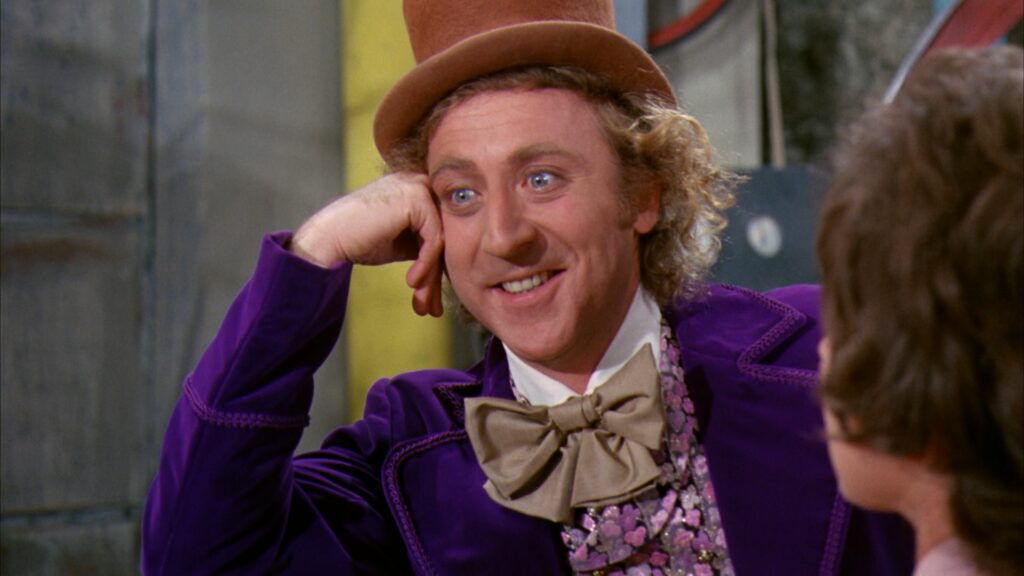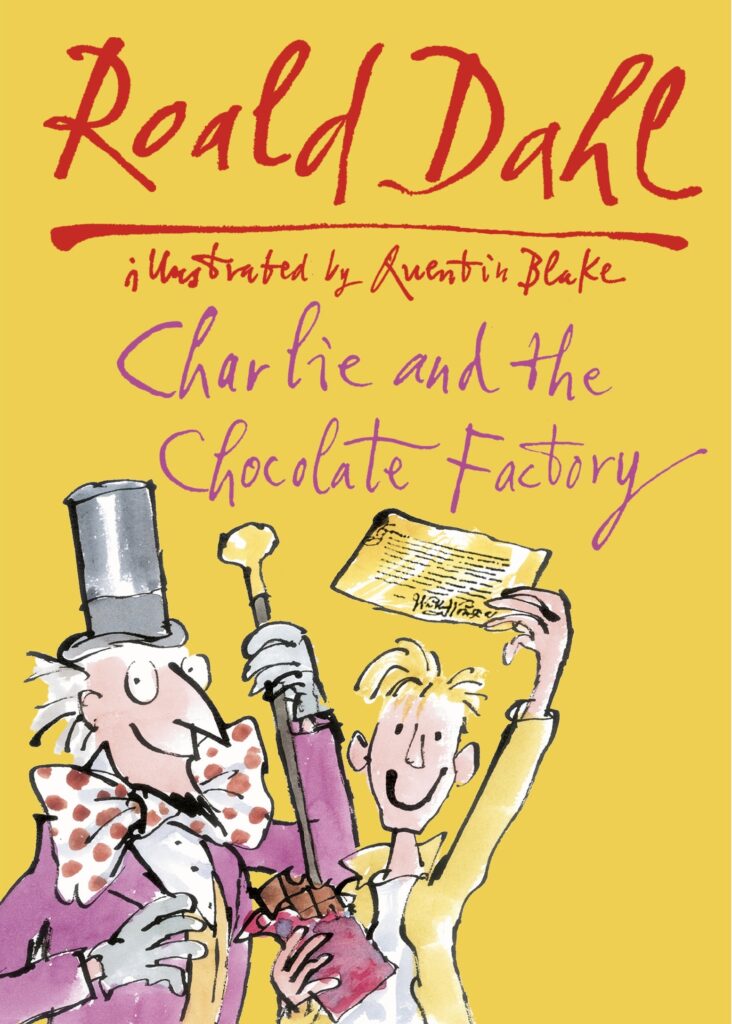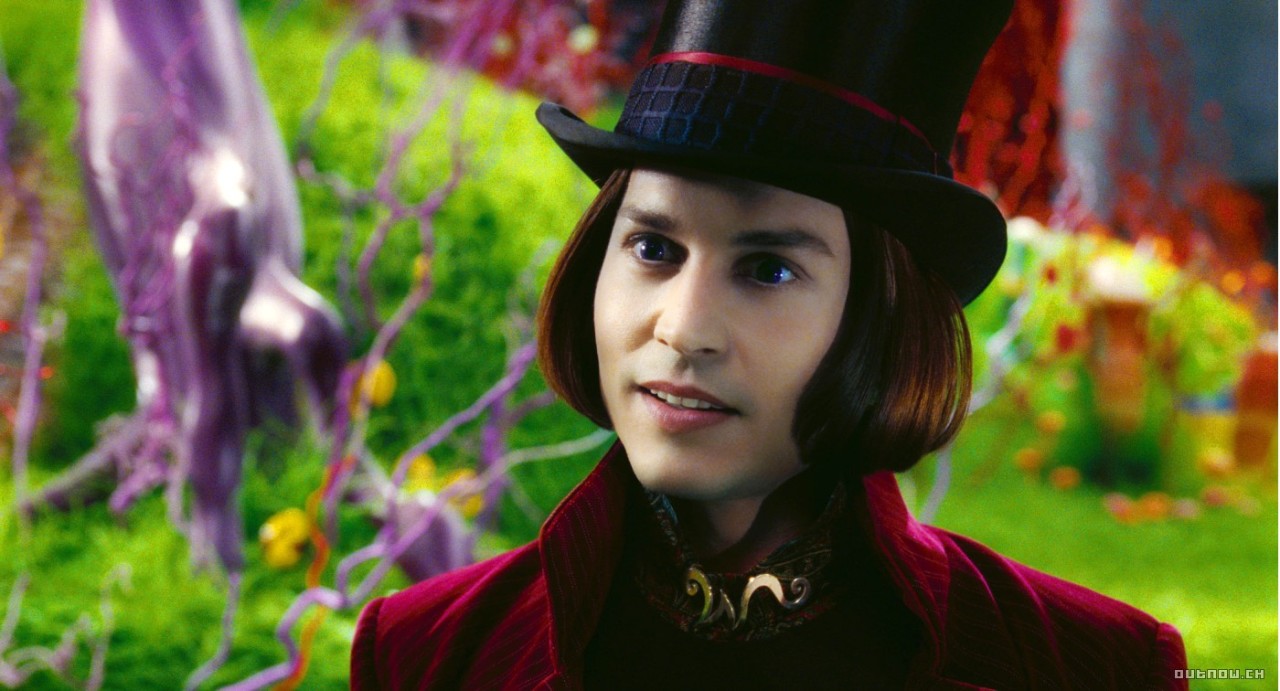Charlie and the Chocolate Factory is a children’s novel by Roald Dahl that was first published in 1964. The story follows Charlie Bucket, a young boy belonging to an economically downtrodden family, who luckily wins a golden ticket to visit the famous Willy Wonka’s chocolate factory. Along with four other children, Charlie gets to see all the wonderfully fascinating things that Wonka has created inside this factory. However, the other children are not as well-behaved as Charlie is, and they soon land themselves in trouble. In the end, Charlie is the only one who leaves Wonka’s factory with a coveted prize.
An English classic, this book has been adapted into two feature films – one in 1971 and one in 2005. Both films stay true to the overall plot of Dahl’s book, but they introduce significant changes to it. The 1971 film, directed by Mel Stuart, is a more faithful adaptation of the book than the 2005 adaptation by Tim Burton. While the former captures the whimsical and magical atmosphere of Wonka’s factory, the latter takes a darker Tim Burton-esque approach to the story.
In this article, we talk about how the 1971 and 2005 film adaptations differ from each other and Dahl’s original text, keeping intact the timeless themes of love and compassion at the center of its sprawling plot.
Major Departures Between the Two Movies
Let us first look into how the 1971 and the 2005 films differed in their adaptation of some of the main elements of Dahl’s book:

-
The Characterisation of Willy Wonka
One of the most notable changes introduced in both movies is the characterization of Willy Wonka. In the book, Wonka is a mysterious and eccentric man who is never seen without his top hat and white gloves. In the 1971 film, Gene Wilder held up this genius character in a charming performance. He was donned with a twinkle in his eye, always upbeat and laughing and full of the uncanny ability to make anyone feel welcome. In contrast, Depp’s performance in the 2005 film was still charming yet extremely secretive. He resisted sharing anything about himself, but the movies lend the audience an insight into his past, giving them an idea of Wonka’s abusive relationship with his father. It is revealed in the process that Wonka’s father never allowed him to eat chocolates.
-
The Portrayal of the Children Visiting Wonka’s Factory
Both movies bring slight changes in their portrayal of the children. As per Dahl’s book, the children are only interested in the chocolate and the prizes that they can win. In the 1971 film, the children are solely greedy, but they are also shown to grow beyond being one-dimensional villains. For example, Violet’s obsession with chewing gum is a defining characteristic for sure, but her ambition and competitive spirit are caveats that the audience’s attention is directed toward as well. Her determination to achieve success and make a name for herself further defines her character. Thereafter, Violet represents the pitfalls of excessive ambition rather than being solely defined by greed.
In the 2005 film, all four children, besides Charlie, are shown to be struggling with their personal demons, trying to find their place in the world. For example, Violet’s mother, a beauty pageant winner and an influential figure in her life, constantly pushes her to achieve greatness, fueling her ambition to succeed at any cost. Her obsession with winning in this movie stems from her desire for validation from her fame-obsessed mother. Throughout the film, it becomes a metaphor for her craving for love and approval as Violet sees success as the only way to earn her mother’s affection and attention. Her competitive nature is a shield that she uses to mask her vulnerability, fearing that without her accomplishments, she will be deemed unworthy and unlovable.
-
The Oompa-Loompa Songs
The oompa-loompa songs in Charlie and the Chocolate Factory are a unique and memorable aspect of the story. In the book, whenever a child meets their misfortune, the oompa-loompas, a group of workers at Willy Wonka’s factory, sing songs to deliver a moral lesson. These songs serve as a form of commentary on the children’s actions and offer insights into the consequences of their behaviour. The songs of the oompa-loompas are known for their peculiar and, sometimes humorous, lyrics, reflecting Roald Dahl’s whimsical and imaginative style of storytelling to engage the child reader by adding a touch of playfulness to the narrative.
However, books and movies are two different mediums, each having their own strengths and weaknesses. They are both great ways to tell stories, but they do it differently. While the songs in the book help the readers paint a picture of the children’s behaviour, the movies use the songs as one of the many devices to introduce a sense of playfulness to the plot. The songs in the book are long and would not have translated well for a musical performance, so the lyrics had to be altered to cater to catchy tunes and easier rhymes for the movie-watching audience. In terms of the overall auditory and visual presentation of the songs of the oompa-loompas, the two directors display orthogonal ideas. While Mel Stuart created a traditional musical with vibrant choreography, Tim Burton opted for a more modern, pop-oriented score with rock and alternative undertones.
Roald Dahl’s Prejudices in Charlie and the Chocolate Factory

Roald Dahl was a man of his time, and his book reflects the prejudices of that time. In Charlie and the Chocolate Factory, the Oompa-Loompas are a group of small, pygmy-like people who work in Wonka’s factory. They are described as ‘happy’ and ‘content’ with their lives, but critics have argued that Wonka is exploiting their labour, comparing their state to slavery. Additionally, the character of Augustus Gloop, a boy who obsesses over food and is deemed gluttonous as his prime trait, was criticised widely as a stereotype of fat people.
The 1971 film adaptation of Charlie and the Chocolate Factory does not address either of these concerns. The Oompa-Loompas are still portrayed as happy-go-lucky workers, and Augustus Gloop is still a fat kid whose flaw lies in gluttony. In Burton’s adaptation, however, some of the prejudices are addressed.
For example, we see the Oompa-Loompas as a community of intelligent and adaptive people who have mastered the art of chocolate-making under Wonka’s tutelage. They demonstrate an understanding of complex machinery and play a crucial role in the day-to-day operations of the factory. Their synchronised performances and choreography during the songs showcase their coordination and talent, highlighting their capabilities beyond their stature as mere employees working under Wonka. While the film doesn’t explicitly delve deeply into their intellect or provide extensive examples of their capabilities outside the factory, their collective abilities and their role in the chocolate-making process suggest a level of intelligence and competence. Additionally, the fact that they have their own language – Oompa-Loompish – and are shown to communicate among themselves further supports the notion of their intelligence and unique cultural background.
Augustus is also shown as a good-natured boy who simply makes a mistake due to his fondness for food. The film humanises him to a certain extent, highlighting that his actions stem from his genuine love for eating food rather than solely representing greed and gluttony. This characterization offers some nuanced insight into his character, emphasising that he is not a bad child but rather one who succumbs to temptation.
It is important to remember that creative works are products of their time, reflecting the views and prejudices of the era in which they were conceived. Any future adaptations can and should paint a fairer, more inclusive narrative, so long as they don’t breach into the original work’s integrity. The Witches, another popular adaptation of a Roald Dahl novel by the same name, was heavily criticised for being disrespectful to the disabled community as recently as 2020. Compared to that, Charlie and the Chocolate Factory has made significant progress across its renditions. One can only hope (and secretly wish) its future movie adaptations improve upon its deficiencies for a nuanced film-watching experience among all kinds of audiences.
The Central Didactic Message in Charlie and the Chocolate Factory
Didacticism is the act of teaching or instructing, and it is often used in children’s literature to help a child distinguish right from wrong. In the book, Dahl uses didacticism to teach children about the importance of hard work, honesty, and kindness. He also instructs the children about the dangers of greed and materialism. The film adaptations keep much of the book’s didacticism intact while adding their unique elements to it. The 1971 film adaptation adds a subplot about the importance of family, while the 2005 film adaptation focuses more on the dangers of consumerism.
In the 2005 movie, some of this didacticism is also directed at negligent or over-cajoling parents. For example, Veruca’s parents are reminded of their failure to set boundaries and discipline her, exposing their responsibility for her demanding and entitled attitude, and Mike’s parents are admonished for their permissive and neglecting parenting, criticising their lack of involvement and Mike’s excessive dependence on technology.
You could argue that the didacticism of the book and the films is essential for their appeal, especially as part of the canon of children’s literature. Children are at a stage of development where they are forming their understanding of the world and acquiring values and principles. Stories that convey moral messages in an engaging and accessible way can have a profound impact on their moral and emotional development.
The book and the movies encapsulate this didactic tradition with their vividly depicted characters and their exaggerated, each story serving as a series of cautionary tales for a child.
Charlie vs The Other Children
Charlie and the Chocolate Factory is ultimately centred around the theme of the importance of being good. Charlie is a good boy who is kind and generous. He is also very humble, and he does not take his golden ticket for granted. The other children, in comparison to Charlie, are not as well-behaved. They are greedy, selfish, and do not appreciate the opportunity of visiting the chocolate factory.
Augustus Gloop, for instance, epitomises greed with his insatiable appetite for chocolate. He disregards basic manners and hygiene. He dove headfirst into the chocolate river without a second thought, showing a complete lack of self-control and respect for his surroundings. Veruca Salt, on the other hand, displays an entitled and demanding attitude. She believes that everything should be hers simply because she wants it. She exhibits an utter disregard for the needs and feelings of others.
Violet Beauregarde’s obsession with chewing gum demonstrates her self-centeredness. She incessantly chews gum, oblivious to the world around her. She ends up disregarding even Mr Wonka’s warnings, leading to her transformation into a blueberry. Mike Teavee, the technology-obsessed child, showcases his lack of appreciation by dismissing the wonder and magic of the chocolate factory in favour of his selfish desires for fame and fortune.
In stark contrast, Charlie Bucket’s humility, gratitude, and selflessness shine through. Despite living in abject poverty, he remains kind-hearted and appreciative of the opportunity presented to him. He doesn’t let his circumstances dictate his behaviour or demeanour. Charlie displays a sense of genuine excitement and wonder throughout the factory tour. He cherishes every moment and expresses gratitude to Mr Wonka for the experience. His good nature and unwavering moral compass ultimately lead him to be the last child standing, proving that he values opportunity more than anyone else. The themes of fairness, kindness, and the consequences of actions in Dahl’s book and its subsequent adaptations have resonated with children across generations, offering valuable insights and fostering moral reflection.
Summing Up
The two films based on Charlie and the Chocolate Factory are very different in tone, characterization, and setting. They are both good films in their own right, but they offer unique experiences to the audience. It is up to you, the individual viewer, to decide which film you prefer.
When you read a book, you picture the story’s progression and its characters in a certain way. It forms a cohesive narrative personal to you. Now, listening to someone else explain to you their version of it is bound to result in a kind of conflict. This is what happens when people watch movies based on books – a director’s interpretation and your expectation converge, leaving only a tiny room for satisfaction. But Charlie and the Chocolate Factory makes for an equally fun read and watch, no matter which of it you choose for entertainment. As long as we use our power of imagination to perceive the world of Willy Wonka, we are guaranteed to be transported to the world of happy nostalgia and chocolates!
Resources
- Charlie and the Chocolate Factory – The Book vs. The Movie – Difference and Comparison | Diffen
- Charlie And The Chocolate Factory: 5 Differences Between The Book & The 1971 Film (& 5 From The 2005 Film)
- Charlie and the Chocolate Factory is the best adaptation of the book : r/movies
- 8 Big Differences Between Roald Dahl’s Charlie And The Chocolate Factory And The 1971 Movie | Cinemablend
- Witches, weirdos, and Wonkas: How to do a Roald Dahl adaptation right
- https://studenttheses.uu.nl/bitstream/handle/20.500.12932/26763/Van%20den%20Broeck_Ella_5485347_BA%20Thesis_Didacticism%20in%20Charlie%20and%20the%20Chocolate%20Factory%20and%20its%20Film%20Adaptations.pdf
- Analyzing the Film Adaptations of Roald Dahl’s Charlie and the Chocolate Factory

